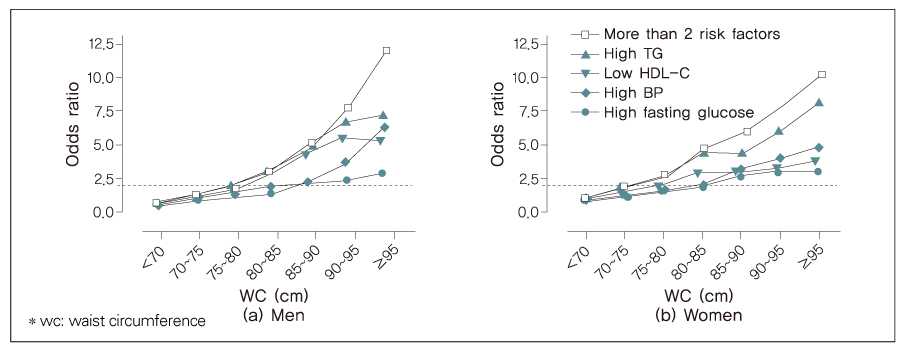J Korean Med Assoc.
2005 Dec;48(12):1165-1172. 10.5124/jkma.2005.48.12.1165.
Cut-off Values of Waist Circumference for Abdominal Obesity among Koreans
- Affiliations
-
- 1Department of Family Medicine, University of Ulsan College of Medicine, Asan Medical Center, Korea. hyesoon@amc.seoul.kr
- KMID: 2015627
- DOI: http://doi.org/10.5124/jkma.2005.48.12.1165
Abstract
- In 2005, the International Diabetes Federation (IDF) presented a new, clinically accessible worldwide definition of 'metabolic syndrome' in a global consensus statement. According to the criteria, central obesity is an essential, not optional, component of metabolic syndrome, which is assessed by ethnicity- and genderspecific cut-off values as measured by waist circumference (WC). Thus we need to have a Korean population-specific WC cut-off values. For this aim, we analyzed data from the 1998 Korean National Health and Nutrition Survey from 6562 participants (2930 men and 3632 women). We determined the appropriate WC cut-offs using receiver operator characteristic (ROC) curve analysis giving the optimal sensitivity and specificity. We estimated multivariate-adjusted odds ratios (ORs) for risk (> or =2metabolic risk factors assessed by IDF) according to the WC categories.The ROC curve analysis indicated that WC was better than BMI in predicting risks. Ageadjusted ORs for having > or =2metabolic risk factors increased abruptly for WC of 90cm in men and 85cm in women, indicating ORs greater than 5.0. WC-compatible 80th percentile was 90cm for men and 86.5cm for women. This analysis demonstrated the appropriate cut-off values of WC for abdominal obesity among Korean are 90cm for men and 85cm for women. These values may be updated, as new data become available.
MeSH Terms
Figure
Reference
-
1. Alberti KG, Zimmet PZ. Definition, diagnosis and classification of diabetes mellitus and its complications. Part 1: diagnosis and classification of diabetes mellitus provisional report of a WHO consultation. Diabet Med. 1998. 15:539–553.
Article2. Balkau B, Charles MA. Comment on the provisional report from the WHO consultation. European Group for the Study of Insulin Resistance(EGIR). Diabet Med. 1999. 16:442–443.3. Expert Panel on Detection, Evaluation, and Treatment of High Blood Cholesterol in Adults. Executive Summary of The Third Report of The National Cholesterol Education Program(NCEP) Expert Panel on Detection, Evaluation, And Treatment of High Blood Cholesterol In Adults(Adult Treatment Panel III). JAMA. 2001. 285:2486–2497.4. The Asia-Pacific Perspective: Redefining Obesity and Its Treatment. 2000. Sydney, Australia: Health Communications Australia Pty Limit.5. IDF Press Conference-Berlin 14/04/05(2005) Background 1: The IDF consensus worldwide definition of the metabolic syndrome. Available from: URL:http://www.idf.org/webdata/docs/IDF_Metasyndrome_definition.pdf.6. Lean ME, Han TS, Morrison CE. Waist circumference as a measure for indicating need for weight management. BMJ. 1995. 311:158–161.
Article7. Han TS, van Leer EM, Seidell JC, Lean ME. Waist circumference action levels in the identification of cardiovascular risk factors: prevalence study in a random sample. BMJ. 1995. 311:1401–1405.
Article8. Examination Committee of Criteria for 'Obesity Disease' in Japan. Japan Society for the Study of Obesity. New criteria for 'obesity disease' in Japan. Circ J. 2002. 66:987–992.10. Park HS, Yun YS, Park JY, Kim YS, Choi JM. Obesity, abdominal obesity, and clustering of cardiovascular risk factors in South Korea. Asia Pac J Clin Nutr. 2003. 12:411–418.14. Ramachandran A, Snehalatha C, Satyavani K, Sivasankari S, Vijay V. Metabolic syndrome in urban Asian Indian adults-a population study using modified ATP III criteria. Diabetes Res Clin Pract. 2003. 60:199–204.
Article15. Wang Y, Rimm EB, Stampfer MJ, Willett WC, Hu FB. Comparison of abdominal adiposity and overall obesity in predicting risk of type 2 diabetes among men. Am J Clin Nutr. 2005. 81:555–563.
Article
- Full Text Links
- Actions
-
Cited
- CITED
-
- Close
- Share
- Similar articles
-
- Effects of Abdominal Obesity and Health Related Physical Fitness in Arterial Stiffness of Korean Males
- Availability of waist circumference as a anthropometric index of abdominal obesity
- Perspective on Diagnostic Criteria for Obesity and Abdominal Obesity in Korean Adults
- Optimal Waist Circumference Cutoff Values for the Diagnosis of Abdominal Obesity in Korean Adults
- Cut-off Values of Visceral Fat Area and Waist Circumference: Diagnostic Criteria for Abdominal Obesity in a Korean Population


